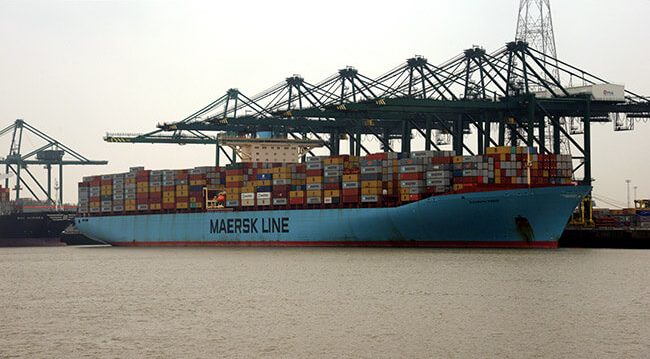The Eleonora Maersk container carrier (15,500 TEU) entered the port of Antwerp this month with a record draught of 15.65 metres, thus breaking the previous record of 15.50 m. With this new milestone the port of Antwerp once again demonstrates that it is perfectly accessible even for the very largest container carriers in the world.
In the Deurganck dock, where the ship is moored, more than 5,000 container movements have been carried out, including 4,300 unloading operations. The vessel is due to leave the port around 1400 hours and then head to Bremerhaven.
The Eleonora Maersk forms part of the AE2 Service operated by the 2M Vessel Sharing Agreement between Maersk Line and MSC linking the Far East and Europe. The container giant has arrived directly from the Malaysian port of Tanjung Pelepas. It was originally scheduled to unload cargo in Tangiers and Southampton first, but in order to make up for a delay at Suez it was decided to sail straight to Antwerp.
Robert Walter, operations manager at Maersk, is very satisfied that the upriver passage along the Scheldt by the 397 metre-long vessel went without a hitch. “Thanks to the excellent collaboration between the Joint Nautical Authority, the pilots, the Port Authority and our shipping company, we managed to make this call in Antwerp a success, which will also enable us to make up for previous lost time,” he declared.
“Everything is possible at the port of Antwerp: we live up to this statement on a daily basis,“ says Luc Arnouts, chief commercial officer for Antwerp Port Authority. The port of Antwerp offers a whole series of advantages to attract customers. These include its location deep inland, which together with its excellent hinterland connections makes it possible to reach the main European centres of consumption very quickly. Not to mention the excellent nautical accessibility and wide variety of added-value activities. “Add the private sector which embodies our reliability and can-do mentality, and all this makes Antwerp an extremely attractive and efficient link in the supply chain,” Arnouts concludes.
Source & Image Credit: Port of Antwerp






























































